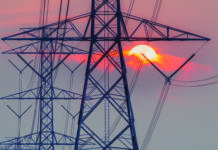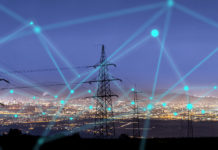
Franck Latrémolière thinks Amazon would make a decent fist of energy supply at scale and might become the catalyst for wholesale systemic change.
Combining Npower with the residential supply business of SSE will create a business which will have lots of customers, including many apathetic (also known as profitable) ones, but no particular competitive advantage.
This new business could be a takeover target for a bold new entrant into consumer-focused electricity and gas supply that wants to have an immediate start at full scale (rather than merely dip a toe in the water).
I say that this bold new entrant is Amazon, and that applying the Amazon business model to energy supply will be good for Amazon, good for customers, and good for the energy industry and its regulation.
Let me unpack these claims.
The main value of SSE + Npower is as a takeover target
Even if you like apes with superpowers, you have to admit that whichever brands the new business ends up keeping will not be particularly impressive. And presumably the SSE name and whatever goodwill goes with the SSE arenas stays with SSE plc. I can see no serious competitive advantage of the new business in the marketing area.
The new business will not have the benefit of vertical integration. Vertical integration is useful by providing financial hedging and stability to a supply business which is otherwise very exposed to movements in market prices and levies. And presumably SSE will load the new business with as much debt as practicable, leaving it financially fragile if it is on its own competing against Centrica, EDF and Big Oil.
The new business does not seem likely to have the engineering or financial capability to be a serious player in being a microgrid provider, energy services company, or wider facility manager, if these ways of doing business turn out to work: these capabilities stay with SSE plc.
My reading of SSE’s announcement is that SSE plc had decided to retreat to the comfortable arms of regulated RPI-indexed cash-flows (regulated transmission, regulated distribution and subsidised generation), and that absorbing Npower was merely an incidental feature of a plan focused on getting rid of the residential supply business. Presumably they tried to flog the business on its own, could not find a buyer willing to pay what they wanted, and then they had the (good) idea of packaging that business together with the equally hard-to-shift Npower.
Amazon has a viable business model to apply to energy supply
My analysis of Amazon’s business model is influenced by Ben Thompson’s excellent articles on stratechery.com, in particular Amazon’s New Customer.
Here is how I foresee the customer experience after the Amazon takeover of SSE + Npower.
Existing customers will be offered free Amazon Prime for six months or a year (or the remaining period of their contract if longer).
The offer to new customers, and to existing customers at the end of the transitional period, will be a choice between an unattractive standard npower variable rate (presumably the Government’s price cap if that happens) and an Amazon Prime Energy subscription (or maybe it would be called Alexa Energy).
Like amazon.co.uk, Amazon Prime Energy would be a platform, not a monolithic supplier. There would be a choice within Amazon Prime Energy between energy supplied by Amazon, energy supplied by others and fulfilled by Amazon (meaning that Amazon would remain the meter registrant but would have a arrangement for the other supplier to provide it with wholesale energy and pay its distribution charges and levies), and energy supplied by other suppliers directly (but with Amazon processing the payment and retaining access to the customer and to consumption data).
The Amazon Prime Energy subscription would be conditional on Amazon Prime membership and probably conditional on monthly meter readings (using either an official smart meter if they ever work, or something like a meter camera or pulse sensor operating as a peripheral to a free Echo Dot). A few days before each monthly renewal date, Amazon would select the best suppliers for electricity and gas for the next month, and notify the customer by email or through Alexa. The customer could override that choice. If the customer rejected the suggested subscription and did not purchase a supply from another Amazon electricity or gas merchant (or switch to a non-Amazon supplier), they would be shunted on the unattractive npower standard variable rate.
If there is demand for that feature, Amazon could easily let customer restrict their supplier choice by factors other than price (for example allowing customers to choose suppliers that can certify that their power is backed by renewable generation or by generation in a particular region).
Naturally any home automation systems that are visible to Alexa would be integrated with energy supply arrangements insofar as that would make sense (which might not be as much as some smart automation enthusiasts seem to believe).
Amazon Prime Energy would not offer any commission to any price comparison websites or other brokers. All suppliers would be welcome to sell on the Amazon Prime Energy platform provided that they offer the same rates as for direct sales, that they comply with Amazon’s rules on data provision and handling customer complaints, and that they pay Amazon’s payment processing fees. I would expect several of the mid-tier suppliers like ScottishPower, Eon or Shell to find Amazon a good way of selling their services.
Amazon would treat its own supply businesses on an equal footing as third-party suppliers using its platform. This might well mean that the npower and SSE supply businesses shrink and whither away, if they cannot develop any competitive advantage. On my analysis of Amazon’s strategic objectives, that would not matter.
In addition to full-service suppliers using Amazon Prime Energy as a route to customer, the Amazon Prime Energy platform would enable a wide variety of new “fulfilled by Amazon” entry routes for suppliers. It is not inconceivable that medium-size generators might find that they make a better living by selling their energy to customers through Amazon than by either setting up their own supply operation or by selling their power to an established supplier.
The radical nature of an Amazon take-over would have been to take a business whose traditional source of profit has been the exploitation of apathetic customers, throw that away, and convert the rest of the business into a modularised Amazon Energy Services business which would allow any willing supplier to serve Amazon’s customers. Financially, the business would migrate from collecting a large profit from a dwindling band of apathetic customers, to collecting a smaller profit from a larger customer base who would have chosen to trust Amazon as an intermediary.
This would be good for Amazon
Creating Amazon Energy Services along the lines outlined above would contribute to Amazon’s strategy to control as many areas of consumer spending as possible. It would play to Amazon’s strengths as a cloud provider to businesses and and as a brand trusted by customers.
To deliver that vision, buying a substantial existing business to act both as a starting point for the infrastructure and as a reference customer for Amazon Energy Services seems essential.
Is starting this in the UK a good idea? It certainly has advantages:
- The UK is already a major Amazon Prime market.
- The UK has an overcomplicated energy industry (making Amazon’s entry assistance for small suppliers particularly valuable, and also reducing the risk that systems built for the UK prove too simplistic for other territories).
- SSE + npower is a superb opportunity: a large retail-only incumbent business that probably does not have too much of a nationalised monopoly culture to overcome.
This would be good for customers
The developments imagined above would be good for customers who want to treat energy supply as similar to food or petrol shopping: a routine purchase which can be made almost on autopilot from a supplier who is trusted to charge a reasonable price (because of competitive constraints).
The current market model for energy supply is to treat it like broadband or car insurance: annual (or less frequent) renewal through a broker or price comparison website. This is an inappropriate model for several reasons:
- Consumption affects costs and prices: energy bills are not flat monthly fees like insurance or broadband. (Energy bills often masquerade as flat monthly amounts, but this is a fiction which is blown apart when the monthly payment gets reviewed to catch-up with actual consumption.)
- Market and policy movements are frequent and significant, so it does not make much sense to lock prices for a year. Price rigidity in the presence of cost fluctuations is a barrier to entry in supply (or the cause of exit for those suppliers who had ignored the barrier to entry).
- There are no differences in actual service quality or scope between energy suppliers. In insurance or telecoms, there are real differences in services or coverage, which might justify annual reviews or broker help. For energy supply (on licensed distribution networks: the situation is different on private grids) the only non-price dimensions are things like competence and honesty.
With Amazon Prime Energy, it will finally be normal to pay for home energy each month on the basis of consumption and competitive market prices. It is a partially controllable and partially predictable regular household expense like grocery shopping or filling up the car.
If I am right that many customers would love Amazon Prime Energy, then it might start looking like a monopoly. But even in the unlikely event that Amazon might be tempted to exploit that position, the risk of monopoly abuse by Amazon would likely be mitigated by competition from Centrica and EDF Energy. At the wholesale level, Amazon Energy Services might not have any competitors, but it would be constrained by the fact that energy suppliers could always self-supply the services they get from Amazon Energy Services.
This would be good for the energy industry
The emergence of Amazon Energy Services will have a beneficial impact on the energy industry, particularly if the “fulfilled by Amazon” concept outlined above succeeds. Creating new ways for generators to get closer to customers would facilitate entry and competition in generation.
Perhaps paradoxically, the potential monopoly position of Amazon Energy Services in providing services to generators/suppliers could also have beneficial impacts. This is because it would be a counterweight to the other centralising monopoly influences in the industry.
Imagine a future world where half of the supply points are within the Amazon system, but Amazon only has a modest share of the supply market (and makes most of its energy sector profits from Amazon Energy Services rather than from supply). That Amazon business would have a strong interest in minimising the non-energy levies that it must collect from its customers on behalf of other monopolists, and to maximise the share of the value which is competed for within its system. It would be in some ways similar to the role that large suppliers (at least British Gas) sometimes play in holding networks to account, but with more power and without the risk of strategic biases to promote the particular interests of a large supply business.
Let me be a little more specific. I see a trend in the electricity sector to shift costs away from wholesale prices and towards levies and network charges. My argument (hope) is that Amazon Energy Services will be a powerful force to prevent unnecessary shifts of value from competitive energy markets to monopolistic ancillary services markets.
For example, the growth in photovoltaic generation may mean that other forms of generation need to ramp up quickly around dusk, especially in seasons where this coincides with the beginning of the evening peak. There is an economic cost associated with this ramping: it might involve operating flexible power stations that have higher fuel costs, and/or “wasting” (constraining off) some late afternoon solar generation to reduce the ramping rate required, and/or using storage (which is then not available to provide response services or arbitrage), and/or imposing a suboptimal schedule on some flexible demand.
A lot of people in the industry today seem to think that a system operator will procure these ramping or ramping mitigation services, and recover the costs through a system operation charge. But ramping costs could also be seen as just energy costs: specifically the value of energy in the hour before dusk is particularly low, and the price of energy in the hour after dusk is particularly high, simply because the most efficient generators cannot produce post-dusk power without producing some pre-dusk power whilst ramping up.
Unfortunately, the centralised and decentralised approaches cannot coexist here. If even a modest amount of ramping is procured as an ancillary services, then this will reduce the natural market price response. As the ancillary service cost is likely to be smeared on a wider charging base than the difference in net demand between before and after dusk, this will mean that the decentralised ramping (without a system operator instruction) will not be profitable, and therefore centralised provision of ramping will have displaced decentralised ramping.
The current political economy favours the centralising approach:
- System operators like to grow their empires and to decide who does what by procuring ramping.
- Flexible generators or demand aggregators like the idea of getting a decent slug of revenue from a long ramping contract with a creditworthy system operator as counterparty.
- Information technology vendors (even those that talk the decentralisation talk) want to build central platforms for innovative services, not just let normal energy prices fluctuations deal with the issue.
- Suppliers who pay ramping levies are too busy competing with each other to care, and many of them might appreciate the cost stability given by a levy compared to volatile energy market prices.
- Energy exchanges might favour decentralisation but their voice is hardly heard.
With a powerful Amazon Energy Services on the scene, the political economy could shift.
If the ancillary services approach is used, Amazon Energy Services would be paying the ramping cost levy and recharging it to its customers (energy suppliers). Flexible generators and aggregators would be collecting ramping payments direct from the system operator, without Amazon involvement. Smaller businesses might be disadvantaged by ancillary services procurement complexity and communications requirements. One of the competitive advantages of Amazon Prime Energy suppliers compared to traditional suppliers, monthly price adjustment, would be less valuable.
By contrast, under the decentralised energy market approach, there would be an opportunity for Amazon to offer intermediation so that all revenues of small generators are earned within the Amazon system, and the competitive advantage of monthly price variations would be more valuable.
And should matters come to litigation, Amazon Energy Services could potentially build a strong argument that it should not be paying the full ramping cost levy insofar as it can prove that the ramping rate of the net demand of Amazon Energy Services registered entry and exit points is proportionally significant lower than the amount of ramping procured by the system operator: the self-balancing Amazon system should not be paying for the failure of other suppliers and generators to mitigate their net ramping.
Can all this happen in practice?
There are a few details to be ironed out to make all this happen.
SSE and Npower need permission from the CMA to establish the joint business. Arguably, a bit of concentration should not be a problem in a market with several large active and diverse competitors, plus a growing competitive fringe. There is currently some opposition to the merger, which is perhaps understandable given the incumbency exploitation business model adopted by the parties to date, but that should not survive rigorous analysis.
Then there is the question of price. Presumably clever merchant bankers have already tried and failed to broker a direct deal with SSE. It is easy to imagine that the current owners of the supply businesses feel obliged to base their view of a fair price on projected profits from continued exploitation of apathetic customers, whereas buyers (including Amazon) are not interested in that.
SSE’s demerger strategy solves this problem: the new business will have a short independent life auctioning itself, and whatever valuation results from that process will be accepted by shareholders as fair. But this means that Amazon has to wait until 2019 to launch an offer.
Waiting until 2019 might carry some risk for Amazon, but that does not seem terminal. And perhaps by 2019 there will be more clarity about the best way of getting monthly meter readings (in particular, whether the government’s smart meter programme has failed).
Plug

I would like a job looking after regulatory matters for Amazon Energy Services, because I would increase profits by promoting competition and preventing undue centralisation.
Franck Latrémolière is an economics consultant, partner of Reckon LLP and editor of the dcmf.co.uk website. This article was originally posted on LinkedIn.
Agree or disagree with this opinion piece? Use the comments section below to share your views.
Related stories:
Can Ofgem expect to win the Triad judicial review?
MPs urge competition watchdog to probe SSE-Npower merger
SSE merger: Npower says business customers will not feel billing pain
SSE customer losses accelerate
Click here to see if you qualify for a free subscription to the print magazine, or to renew.
Follow us at @EnergystMedia. For regular bulletins, sign up for the free newsletter.




Very interesting and reasoned article. Even Labours renationalisation plans and argument would be difficult to sustain with this format.
An interesting idea. But it begs the question. Why would a hyper efficient organisation like Amazon want to take on the administration black holes that comprise NPower and to a slightly lesser degree SSE.